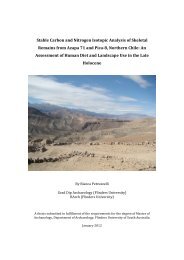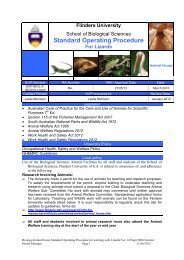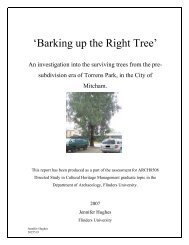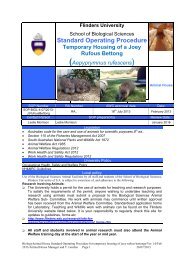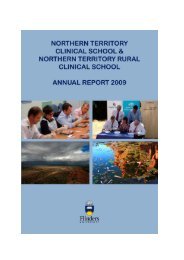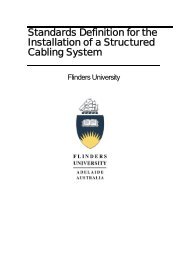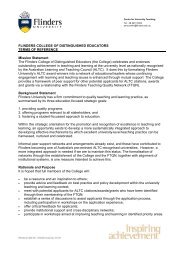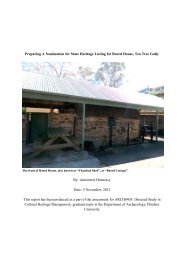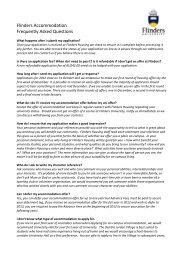Land Management Plan 2004 - 2050 Flinders University South ...
Land Management Plan 2004 - 2050 Flinders University South ...
Land Management Plan 2004 - 2050 Flinders University South ...
Create successful ePaper yourself
Turn your PDF publications into a flip-book with our unique Google optimized e-Paper software.
<strong>Flinders</strong> <strong>University</strong> <strong>Land</strong> <strong>Management</strong> <strong>Plan</strong> <strong>Flinders</strong> <strong>University</strong><br />
<strong>2004</strong> - <strong>2050</strong> <strong>South</strong> Australia<br />
4.2.1 Trails Strategy<br />
In addition to the recommended trail extensions and monitoring / maintenance, the value of trails for<br />
recreational users can be further developed.<br />
The <strong>Flinders</strong> <strong>University</strong> site, with its prominent location on the Adelaide Hills face and uninterrupted views<br />
over metropolitan Adelaide, is an excellent site for recreation. Currently, the trails are used casually by both<br />
students, staff and the general public as well as organised events, such as the mountain bike summer series.<br />
It is noted that an ‘exercise loop’ is established within the Aleppo Precinct, however the general awareness of<br />
this is unlikely to be high, due to a lack of signage.<br />
The potential for an interpretative trail, winding the length of the Main Valley (Precincts 1, 2 and 7), to enhance<br />
the visitor awareness of the site’s attributes is considered worthy of implementation. This could be developed<br />
over time, with signage initially explaining the intent and program of pest plant removal and subsequent<br />
revegetation. This would also provide opportunity for partner agencies to demonstrate their involvement and<br />
elicit interested persons to assist in the implementation – through weed removal, vegetation etc. Later signage<br />
should include information about the likely Aboriginal use of the area (<strong>South</strong>ern Mt Lofty Region), indigenous<br />
vegetation associations, fauna, geology and catchment awareness. The signage design and content could be<br />
developed as part of a student project for the design school within the <strong>University</strong>.<br />
As previously noted, the lack of adequate access trails to all areas within the study area has made<br />
maintenance difficult. To address this problem, and provide improved recreational opportunities, the following<br />
key recommendations are made:<br />
• Precinct 4 – whilst access to this precinct is probably the constraining factor for management work being<br />
undertaken, it is not recommended that additional access trails be constructed in the short to medium<br />
term. The steepness of the northern slope (of <strong>South</strong> Valley) is particularly problematic for trail<br />
construction, and it is likely that a recreational trail would be the only achievable option on this slope.<br />
Given that a recreational access trail has been recommended on the southern side of this valley through<br />
Precincts 5 and 6, a trail in this precinct would duplicate that facility.<br />
The weed control techniques recommended for this precinct are cognisant of the accessibility constraints<br />
and therefore require no physical removal but rather in-situ treatments such as ringbarking and stem<br />
injection. This precinct has been given the equal lowest priority of the study area, as it is acknowledged it<br />
has a high weed density in conjunction with significant accessibility constraints.<br />
• Precinct 5 and 6 – as previously noted, the access track from the shared-use path has recently been<br />
extended into Precinct 5. Whilst this allows maintenance vehicle access to the upper slope there is<br />
currently no means of accessing the lower area by vehicle. To rectify this it is proposed that the track be<br />
extended, via a series of switchbacks, to eventually reach the creek, which will be followed to the western<br />
boundary.<br />
Where the track reaches the creek, it is proposed that a recreational trail should continue east, following<br />
the creek alignment along the southern side, until rejoining the vehicle track in Precinct 6. This trail is<br />
proposed to provide a more interesting route for recreational users, and also to allow foot access for<br />
management work along the riparian zone and surrounding high and moderate quality Eucalyptus<br />
microcarpa Woodland.<br />
• Precinct 7 – starting from the existing track in Precinct 2, aligned north-south and adjacent the electricity<br />
easement, this trail should follow the contours as closely as possible on the southern slopes of the valley.<br />
There is a gain of approximately 60 metres over the approximately 750 metres from the boundary of<br />
Precinct 2 to Offler Avenue. This would result in a grade average of 8 percent. Due to the topography of<br />
the valley, in that it gains approximately 40 metres from the confluence of the two creeks before reaching<br />
the eastern boundary (a straight line distance of approximately 250 metres), it is anticipated at least three<br />
switchbacks will be required over this section to achieve a sustainable gradient.<br />
This design approach will increase the length of the trail, to approximately 400 metres, but should<br />
substantially reduce the risk of erosion. The indicative alignment has been selected to make use of<br />
already cleared areas, however the route will need to be confirmed on site by an ecologist to ensure any<br />
loss or damage to native vegetation (including grasses) is minimised. Whilst the loss of some native<br />
vegetation is regrettable, it is considered that without adequate access it is likely that the area will<br />
become further degraded through weed infestation.<br />
It is noted that this option does not provide the double benefit of creating a fuel reduction zone along the<br />
northern property boundary however the steepness of this alignment is too steep for a sustainable trail to<br />
be constructed. Access to the northern boundary (for fuel reduction purposes) will still need to be<br />
undertaken on foot, however it is considered the proposed trail will make this task somewhat easier.<br />
The recently constructed mountain bike trail in the western end of this precinct has been completed to the<br />
standards of the International Mountain Bike Association (IMBA) which are world’s best practice for<br />
recreational trail construction. These standards include an average grade of 10 percent, grade reversals<br />
and a full bench tread, all of which are integral to ensuring a sustainable trail (refer to www.imba.com for<br />
further information). This standard should be applied to future trail construction for recreation purposes<br />
whilst the general principles relating to gradient, drainage and construction should also be incorporated<br />
into design for vehicular tracks.<br />
• Sturt Creek Linear Park – Sturt Gorge Recreation Reserve linkage it has been mooted by a number<br />
of agencies that the potential to provide a continuous trail along the Sturt Creek corridor could soon be<br />
realised. The major impediment, till now, has been the private ownership of a short section of the river<br />
adjacent to <strong>Flinders</strong> <strong>University</strong>. The possibility of utilising a section of existing track in Precinct 4, to<br />
complete the connection, has the in-principle support of the <strong>University</strong>.<br />
At present, this track terminates at a private driveway, with no continuation through to the Gorge. If further<br />
access at this point is unable to be negotiated, it is proposed that the trail could be aligned with the<br />
property boundary adjacent the private driveway and residence where it would join the track from Precinct<br />
5 before continuing through to Sturt Gorge.<br />
The creation of a linear trail linking Sturt Creek Linear Park and Sturt Gorge further emphasises the need<br />
for adequate weed control and Phytophthera hygiene measures within <strong>Flinders</strong> <strong>University</strong> land.<br />
4.2.2 Trail Monitoring and Maintenance<br />
The majority of formal tracks used for vehicle access have been used over many decades and consequently<br />
these show few signs of degradation. However, there are a few sections where grades exceed 10 percent,<br />
and they follow the fall line, and erosion is evident. The placement of imported fill material may temporarily<br />
alleviate the problem but in some cases an alternative solution, engineered or otherwise, is required. A few of<br />
the observed problems, and recommended solutions are noted below:<br />
• Gully erosion (Precinct 2, section of north-south track adjacent electricity easement);<br />
⏐ AUGUST <strong>2004</strong> ⏐ PAGE 10






